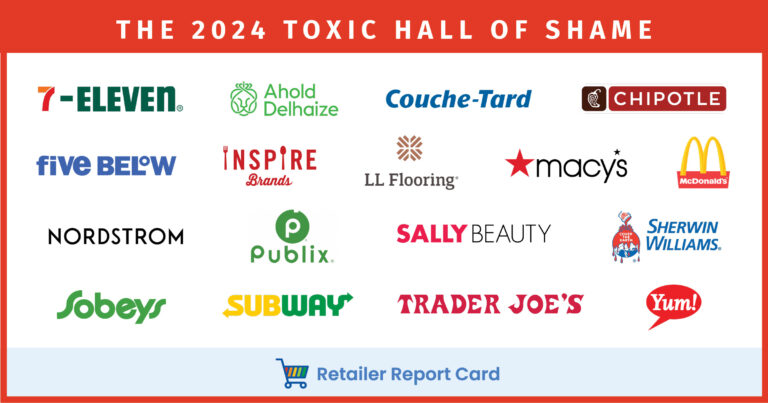FAQs: PFAS in breast milk
What are the concerns about these new findings?
We found that levels of current-use PFAS appear to be rising in breast milk. These findings make it clear that when companies phased out certain PFAS and switched to others, it didn’t solve the exposure problem. Instead, the findings suggest that current-use PFAS are building up in our bodies.
How do PFAS threaten our health?
Studies link exposure to PFAS with a weaker immune system, cancer, increased cholesterol levels, and increased risk of thyroid disease. In laboratory studies, PFAS are also associated with reproductive, neurodevelopmental, liver, and kidney problems.
An increasing number of scientists have made strong statements of concern based on studies showing that PFAS can weaken the immune system and make people more vulnerable to infectious diseases like colds, stomach bugs, and Covid-19. PFAS exposure may weaken infectious disease resistance, meaning that people are more likely to get sick from viruses after being exposed.
How are people exposed to PFAS chemicals?
Companies put these synthetic chemicals in products like food packaging, stain-resistant carpet and fabrics, water-repellent outdoor gear, firefighting foam, waxes and sealers for flooring and other building products, nonstick cookware, and household items like makeup.
PFAS are released into air and water by manufacturers and escape from products while we use them, contaminating our air, soil, food, water, homes, and workplaces. They also leach out of products discarded in landfills. As a result, PFAS contaminate drinking water supplies for millions of Americans.
How can I protect my family from PFAS?
It is virtually impossible to avoid exposure to PFAS altogether. To lower exposure:
- Avoid stain-resistance treatments on furniture and carpet.
- Avoid greasy or oily packaged foods, takeout food, and microwave popcorn. These packages often contain grease-resistant coatings like PFAS.
- Avoid personal-care products made with TeflonTM or containing ingredients that include the words “fluoro” or ”perfluoro.” PFAS can be found in dental floss and a variety of cosmetics.
- Avoid TeflonTM or non-stick cookware. Stainless steel or cast iron are better alternatives.
Why is it important to breastfeed?
According to doctors, when possible, breastfeeding is the healthiest choice for moms and babies. Breastfed babies have fewer infections and reduced risk of asthma, obesity, diabetes, and other health problems. Breastfeeding can also improve mothers’ health, reducing risk of high blood pressure, diabetes, breast cancer, and other health problems.
Have you seen any progress on this issue?
Since 2018, state and local governments together with companies have led the way by adopting policies and actions to prevent PFAS pollution, focusing on key sources including food packaging, firefighting foam, and textiles.
The first laws, adopted in Washington, Maine, New York, and San Francisco, were groundbreaking— regulating the full class of more than 5,000 PFAS chemicals in food packaging and sending a clear signal to the market to find safer alternatives. Companies from McDonald’s to Whole Foods are moving away from PFAS in food packaging. And in July 2020, the major U.S.-based PFAS chemical makers agreed to voluntarily phase certain PFAS out of food packaging by 2024.
Multiple states also led the way by banning PFAS-containing firefighting foam, a major source of PFAS in drinking water, and requiring disclosure of PFAS in firefighting turnout gear. States such as Washington, California, and Vermont are considering restrictions on PFAS in carpets, rugs, and other textiles.
The European Union is developing restrictions on use and manufacture of all PFAS under the European Registration, Evaluation, Authorisation and Restriction of Chemicals program.
What still needs to be done?
Local, state, federal governments and product manufacturers, suppliers, and retailers should:
- Adopt policies to prevent the use of the most dangerous chemical classes, such as PFAS, that wind up in people and breast milk. Phase out these chemicals in uses where safer alternatives are available.
- Require full public disclosure of product ingredients in laws and corporate policies so that suppliers, manufacturers, governments, and consumers know what chemicals are in products.
- Invest in the tools, science, and data that identify and incentivize the use of the safest chemicals and materials.
- Adopt strong standards to require testing and cleanup of PFAS in drinking water, soil, groundwater, sludge (biosolids), and sediment.
- Ensure safe storage and disposal of PFAS-containing products and wastes.
What can individuals do?
People can learn how and when to contact elected officials and retailers to prevent PFAS pollution by signing up for Toxic-Free Future’s email list.
Take action now!

FAQs
- I.FAQs: PFAS in breast milk
